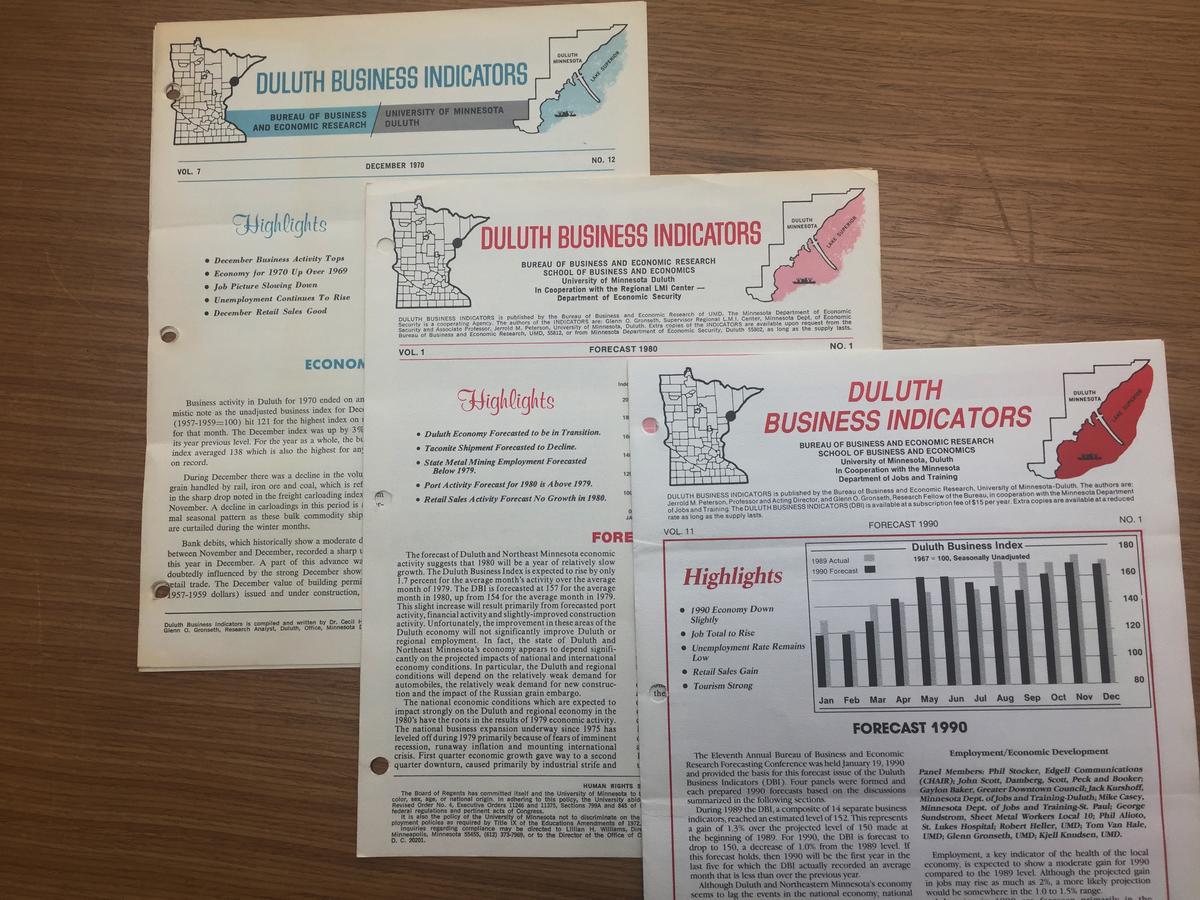Photo: An issue of the Duluth Business Index from 1970, 1980, and 1990.
In the 1960s, Duluth’s economy was struggling and data pertaining to economic development was fragmented at best. It wasn’t clear if the data that the community did have could be used to generate industrial or commercial prospects, and there was little effort toward getting the data into a functional form. (Danzl, 2018)
In 1963, Dr. Cecil H. Meyers, UMD professor of economics, joined forces with Glenn O. Gronseth, research analyst for the Duluth office of the Minnesota Employment Security Division to embark on what was to become an immensely powerful and popular research project—the Duluth Business Index (DBI). Gronseth stated that he and Cecil Meyers “became concerned by the amount of criticism being leveled at the Duluth economy and felt that there had to be a way to prove that we were not as bad off as we were supposed to be” (UMD News Service, 1984). The two believed that this index would provide an objective measurement of regional economic activity and could be used by local area business and industrial leaders for immediate and long-run decision making.
The two laboriously gathered economic data on Duluth from 1951 to 1963, creating an index to measure current economic activity and offer a historic economic perspective. Mr. Arthur Barschdorf of the Industrial Development Division of Minnesota Power and Light assisted in the project’s initial development (BBER, 2018)
The first issue of the DBI was published in May of 1964 (UMD, 1964) and was based on information from 15 sources that represented the basic economic elements in the community: railroad car loadings, bank debits, building permits, postal receipts, telephones, commercial use of electric power, residential use of electric power, coal receipts, iron ore, grain, general cargo, employment, department store sales, and state metal mining employment (BBER, 2018).
The benefit of the DBI for local stakeholders was that it was unique to the Northeast region of Minnesota. While the economy of the Twin Cities, and much of the rest of the state, was based on technology, finance, and retail, the economy of Northeastern Minnesota was based on mining, timber, and tourism. Often, when the state economy was going well, Duluth was in a recession (or vice versa). The DBI was also unique in that it was developed far before any similar reports were created for the Twin Cities or greater Minnesota (UMD News Service, 1984).
Gronseth and Myers typically had two students employed at any given time. The team prepared the monthly DBI by calling businesses on the phone, asking about metrics, such as retail sales, electric power usage, and more. The monthly index reflected the output of economy.
Over time, the data was used widely by many stakeholders in the region and beyond. Apparently, even the Federal Reserve would call to ask about movements in the DBI.
When asked about the relative importance of the DBI, David Raimo, the then manager of research and public affairs for the Duluth Area Chamber of Commerce, stated that the index “provides us with the information to answer the hundreds of inquires we receive from individuals and businesses regarding Duluth’s economy” (UMD News Service, 1984). Dennis Dunne, the then president of Norwest Bank valued the DBI because it allowed for the identification of trends within Duluth’s economy and, thus, aided in strategic planning (UMD News Service, 1984).
The business indexes continued to be pivotal data and information for the Duluth community and were published until the late-1990s when it became increasingly difficult to gather the needed data.
